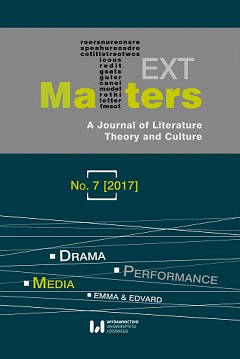Éowyn and the Biblical Tradition of a Warrior Woman
DOI:
https://doi.org/10.1515/texmat-2017-0022Keywords:
Tolkien, Éowyn, Bible, Jael, JudithAbstract
The article discusses the portrayal of Éowyn in Tolkien’s The Lord of the Rings in the light of the biblical tradition of the warrior woman. The author focuses on the scene in which Éowyn slays the Nazgûl Lord in the battle of the Pelennor Fields with the help of Meriadoc. This event is juxtaposed against the biblical descriptions of female warriors, in particular Jael and Judith. A detailed analysis of passages from the King James Bible and the Douay-Rheims Bible, with which Tolkien was familiar, allows the reader to detect numerous affinities between his vocabulary and imagery, and their biblical antecedents. Filipczak contends that, by defending the body of the dying Théoden, Éowyn defends the whole kingdom; her action can be interpreted in the light of The King’s Two Bodies by Ernst Kantorowicz. Her threat to the Ringraith (“I will smite you if you touch him”) makes use of the verb that can be found in the descriptions of Jael and Judith in the Protestant and Catholic Bibles respectively. Furthermore, Éowyn’s unique position as a mortal woman who achieves the impossible and thus fulfills the prophecy paves the way for a comparison with the Virgin Mary, whose Magnificat contains elements of “a holy-war song” which were suppressed by traditional interpretations. Consequently, the portrayal of Éowyn blends the features of Jael, Judith and Mary with allusions to St. Joan of Arc. Moreover, her act of slaying the Ringraith’s fell beast reinterprets the story of St. George and the dragon. Filipczak argues that Éowyn’s uniqueness is additionally emphasized because she acts out Gandalf’s words from Minas Tirith and sends the Nazgûl Lord into nothingness.
Downloads
References
Allen, Prudence. The Concept of Woman Vol. 2: The Early Humanist Reformation, 1250–1500, Part 2. Grand Rapids, MI: William B. Eerdmans, 2005. Print.
Google Scholar
Bal, Mieke, and Michelle Williams Gamaker. Madame B. Video Exhibition. Łódź: Muzeum Sztuki, 2013.
Google Scholar
Brennan Croft, Janet. “Bid the Tree Unfix His Earthbound Root: Motifs from Macbeth in J. R. R. Tolkien’s Lord of the Rings.” Tolkien and Shakespeare: Essays on Shared Themes and Language. Ed. Janet Brennan Croft, Donald E. Palumbo and C. W. Sullivan III. Jefferson: McFarland, 2007. 215–26. Print.
Google Scholar
Brenner-Idan, Athalya. “A Triangle and a Rhombus in Narrative Structure: A Proposed Integrative Reading of Judges 4 and 5.” Feminist Companion to Judges. Ed. Athalya Brenner-Idan. London: Bloomsbury, 1993. 98–109. Print.
Google Scholar
Burns, Marjorie. “Saintly and Distant Mothers.” The Ring and the Cross: Christianity and “The Lord of the Rings.” Ed. Paul E. Kerry. New York: Rowman and Littlefield, 2011. 246–59. Print.
Google Scholar
Ganong Walton, Christina. “Bible.” J. R. R. Tolkien Encyclopedia: Scholarship and Critical Assessment. Ed. Michael D. C. Drout. New York and London: Routledge, 2007. 62–64. Print.
Google Scholar
Griffiths, Paul J. Song of Songs. Grand Rapids, MI: Brazos, 2011. Print.
Google Scholar
Jeffrey, David L. A Dictionary of Biblical Tradition in English Literature. Grand Rapids, MI: William B. Eerdmans, 1992. Print.
Google Scholar
King James Bible. Kingjamesbibleonline.org. Web. 2017.
Google Scholar
Klein, Lillian R. The Triumph of Irony in the Book of Judges. London: A&C Black, 1988. Print.
Google Scholar
Magennis, Hugh. “Gender and Heroism in the Old English Judith.” Writing Gender and Genre in Medieval Literature: Approaches to Old and Middle English Texts. Ed. Elaine Treharne. Rochester: D. S. Brewer, 2002. 5–18. Print.
Google Scholar
Massyngbaerde Ford, Josephine. My Enemy Is My Guest: Jesus and Violence in Luke. Eugene, OR: Wipf and Stock, 2010. Print.
Google Scholar
Neville, Jennifer. “Women.” Reading “The Lord of the Rings”: New Writings on Tolkien’s Classic. Ed. Robert Eaglestone. London: A&C Black, 2006. 101–10. Print.
Google Scholar
Scott Franklin, Daniel. Sweden: the Nation’s History. Carbondale, IL: Southern Illinois UP, 1988. Print.
Google Scholar
Tolkien, John R. R. Lord of the Rings, The Return of the King. London: Harper and Collins, 2012. Print.
Google Scholar
Tolkien, John R. R. Lord of the Rings, The Two Towers. London: Harper and Collins, 2012. Print.
Google Scholar
Wicher, Andrzej. “Gandalf i Galadriela jako Tolkienowskie metafory mądrości.” Figury i znaczenia mądrości. Studium interdscyplinarne. Ed. Marta Zając. Katowice: Wydawnictwo Uniwersytetu Śląskiego, 2016. 123–57. Print.
Google Scholar
Downloads
Published
How to Cite
Issue
Section
License
Copyright (c) 2017 A Journal of Literature, Theory and Culture

This work is licensed under a Creative Commons Attribution-NonCommercial-NoDerivatives 4.0 International License.













